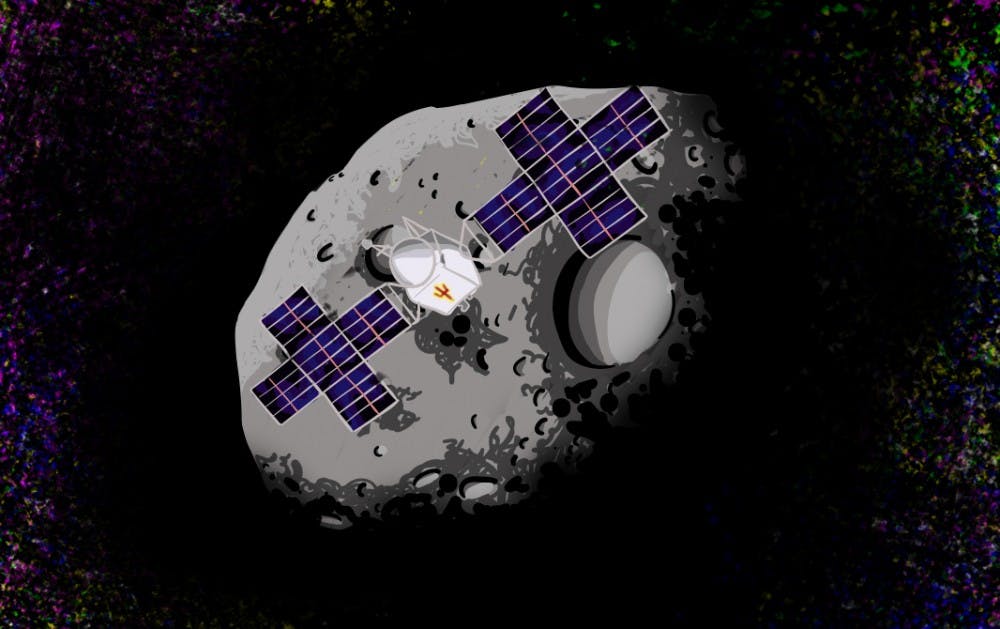ASU led-team Psyche, a first-of-its-kind mission to collect data from a fully metal asteroid, has finished the design of the spacecraft that is scheduled to launch in 2022.
The group was selected by NASA in January 2017 and is currently in the second of its six phases. Psyche is a fully metal asteroid currently orbiting between Mars and Jupiter and the namesake for the NASA mission. The mission will send out a robotic spacecraft in 2022, and it will arrive in 2026 to orbit the asteroid for 21 months while collecting data.
Principal Investigator Lindy Elkins-Tanton, director of ASU's School of Earth and Space Exploration, said the unique meteor is made out of the same material as the earth's core.
Elkins-Tanton put together the team that pitched to NASA, going against other research teams looking to get funding for their own work. She said she focused on Psyche because given its earth core-like material, studying the asteroid could bring new information about Earth.
“It’s the only large metal object in our solar system," Elkins-Tanton said. "There are a few other metal asteroids that look like they're smaller pieces, but we won't know for sure until we get there."
For this competition, the team composed the entire pitch — including where the mission is going, what the spacecraft will measure, how it will be measured, how much it costs and the length of the mission from start to finish.
Altogether, the Psyche mission will cost $850 million.
Hannah Bercovici, a graduate student in the School of Earth and Space Exploration, said this mission is integral to understanding our own planet's core. Bercovici works in a research group led by ASU professor Jim Bell, Psyche's deputy principal investigator.
"The core of our planet is like 1,800 miles underneath the surface, and so that's impossible to get to," Bercovici said. "The deepest that humans have ever recorded is about seven and a half miles."
Psyche is by far the largest metal asteroid in our solar system, measuring 140 miles in diameter, if measured as a perfect sphere, and is a little less than 1 percent of the entire mass of the asteroid belt.
Along with a team of more than 200 people, project Psyche partnered with the Jet Propulsion Laboratory and SSL to build the spacecraft chassis, which is the body of the spacecraft.
“We have eight standing meetings every week, and we have reviews every single week for different parts of the subsystem,” Elkins-Tanton said. “We also have an external standing review that comes and makes sure that we’re ready for the next phase and right now we’re in the formulation phase, and next were going to go into the phase of actually building the spacecraft.”
The body of the spacecraft is the size of a smart car and about as tall as a regulation basketball hoop. Including the solar panels, the spacecraft is 81 feet long – the size of a tennis court.
The spacecraft uses an electric propulsion system that is powered by the solar panels. The body is equipped with instruments such as magnetometer, gamma ray and neutron spectrometer, a multispectral imager and an x-band radio telecommunications system.
"The imager will be used to look at different rock components on the surface as well as any sulfites," said Steven Dibb, a graduate student also on Bell's team. "The gamma ray spectrometer will also allow us to determine the elemental composition of the surface."
David Williams, deputy lead for the spacecraft imager and an associate professor in the School of Earth and Space Exploration, said that the spacecraft is similar to other discovery-class spacecrafts of its type, such as the Dawn mission.
"It's a solar powered spacecraft, it's going to use cold gas thrusters to move around and it's got what's called ion propulsion, where it uses xenon gas and it ionizes that gas to give it momentum to move through the solar system," Williams said.
Before launch, the thrusters will be sent to the Glenn Research Center in Ohio, where there is a vacuum chamber to test the propulsion system in a space-like environment.
Beyond bringing new research about the asteroid, the Psyche mission is bringing an opportunity for younger researchers to get involved.
"Part of what NASA really wants to do is make sure that we're educating our youth about the importance of science and the importance of space exploration," Karin Valentine, a spokesperson for the School of Earth and Space Exploration said. "Psyche is part of that overall goal for NASA to help people become involved in missions that we're doing as a country."
Reach the reporter at amville8@asu.edu or follow @AustinMVillegas on Twitter.
Like State Press on Facebook and follow @statepress on Twitter.




